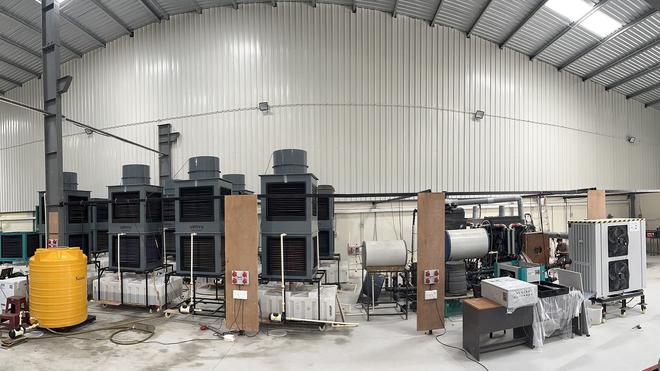In 2016, Swapnil Shrivastav and Venkatesh R.Y., the founders of the Bengaluru-based Uravu Labs, a start-up working on renewable water technology, experienced first-hand the impact of water shortage.
They were both students at the National Institute of Technology, Calicut, back then, says Shrivastav, recalling the dry spell the city of Kozhikode went through that year. When the river near the institute, its primary source of water, started drying up, NIT turned to water tankers to supply their staff and students with water.
“But with so many students in the hostel, you cannot keep calling water tankers,” says Shrivastav, adding that water had to be rationed to one to two buckets per person per day back then. “That was a trigger. It got me thinking about water, in general.”
They began researching technology that could create water from the air and continued their experiments even after they graduated, and took up a job. These initial prototypes used refrigerants to help condense atmospheric water, a technology similar to that employed in air conditioners.
However, this was neither very efficient nor very sustainable, pointed out Shrivastav. “We thought we would continue doing this and see where it goes,” he said, adding that they did this part-time for a while, convincing their landlord to let them experiment in the area surrounding their rented accommodation in Bengaluru.
Changed technology
By 2018, they had changed their technology, using desiccants, substances that are capable of absorbing water from the air, instead of refrigerants. “We wanted to look at something not dependent on electricity,” he says, adding that they began using silica gel to trap moisture in the air. This moisture, in turn, gets desorbed using heat generated from a renewable energy source, and the water vapour released is condensed and then collected.
Around the same time, Tata Group-backed Water Abundance XPRIZE, a global contest offering a considerable grant to teams that could successfully create low-cost, energy-efficient technologies that could help alleviate the looming global water crisis. When they won the XPrize Grant, the duo quit their day jobs and decided to do this full-time, going on to add two members to the team-- Govinda Balaji and Pradeep Garg. In October 2019, the four came together and found Uravu Labs, the name was inspired by the Malayalam word for “spring of water.”
Upping their game
Today, Uravu Labs has the capacity to produce nearly 3000 litres of water per day; they hope to scale up further and produce at least 10,000 litres of water out of the air by the end of the year. “The more you scale, the more the cost per litre of water goes down,” says Shrivastav.
From a levelized cost perspective, producing around 20 litres of water comes to rupees six to rupees seven per litre. “As we scale up, as we reach 200-500 litres per day, this becomes around rupees four to rupees five per litre,” he says. “And when we reach 2000 to 10,000 per day scale, it becomes rupees two to rupees three per litre”
The desire to scale was the reason they chose to change the desiccant used in the technology, switching from the solid silica gel to a proprietary salt solution in 2021. “Liquid is much easier to scale,” he says, adding they were only generating five litres of water per day.
In the year 2021, the start-up raised its first round of funding, an undisclosed amount led by Speciale Invest, along with angel investors like Peter Yolles, Soren Schroder, Shigeru Sumimoto, and Tomoki Kaneko. “This gave us a good amount of resources to build the product and improve technology,” he says.
Recently, in March 2023, the startup raised another round of funding, around $2.3 million. This round of funding, led by Anicut Capital and co-led by Rocketship.vc and Speciale Invest, funds, is being used to scale the business further. “We have filed three patents and have another few in the works,” he says.

They have also started to sell the water generated by this technology to the beverage and hospitality industry, selling this renewable, purified water in glass bottles that can be reused.
“The beverage industry uses 1500 billion litres of water annually, less than agriculture, but more than what goes into personal use,” he said. Much of this comes from rapidly depleting ground-water sources, the purification of which leads to additional water loss.
“With every litre of water, we produce, we can save two to three litres of groundwater, which can be diverted to other things,” he said.







